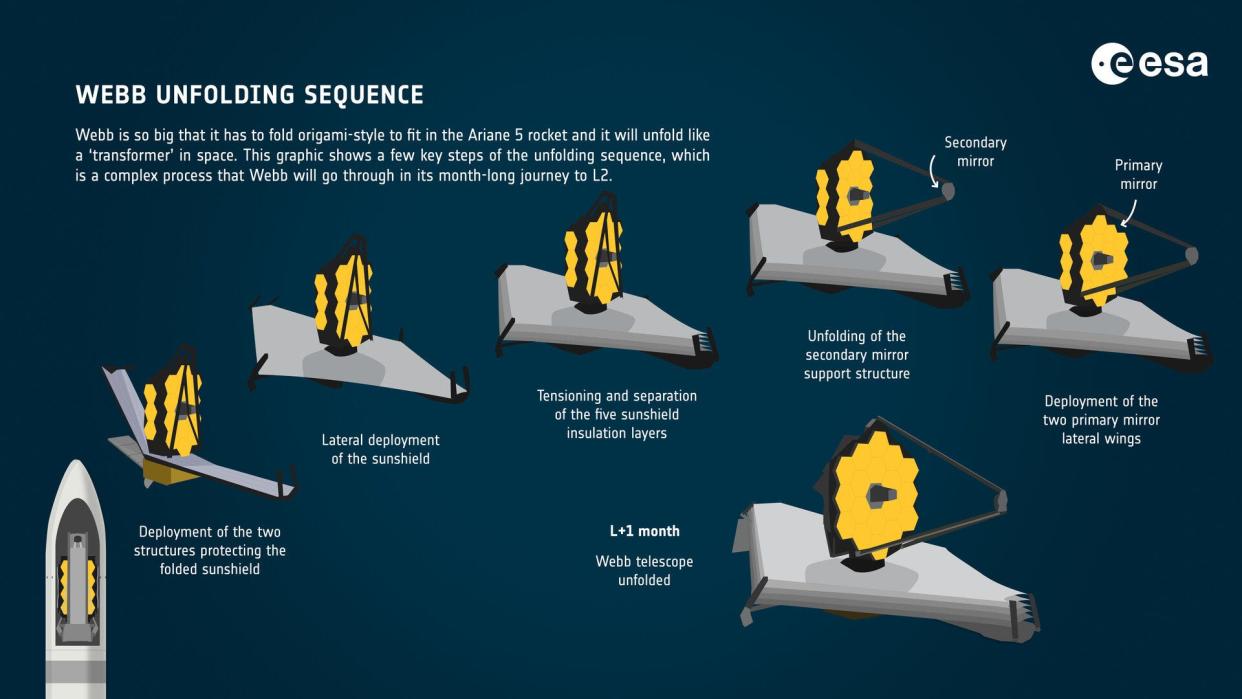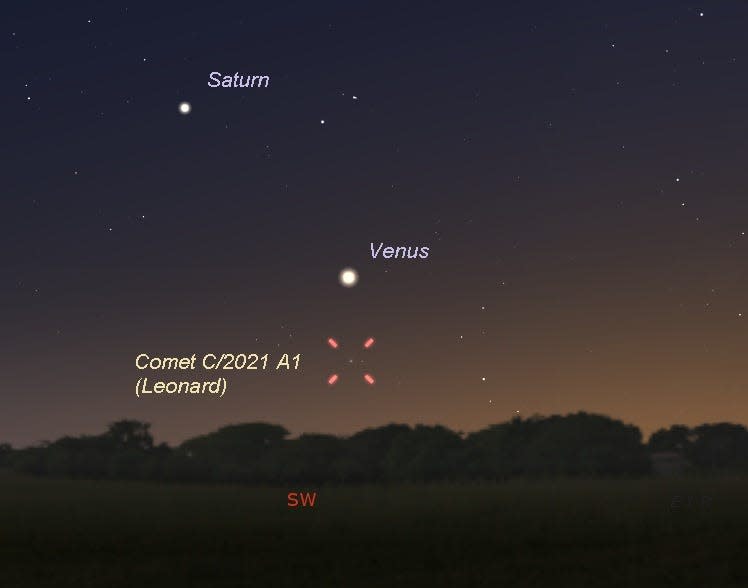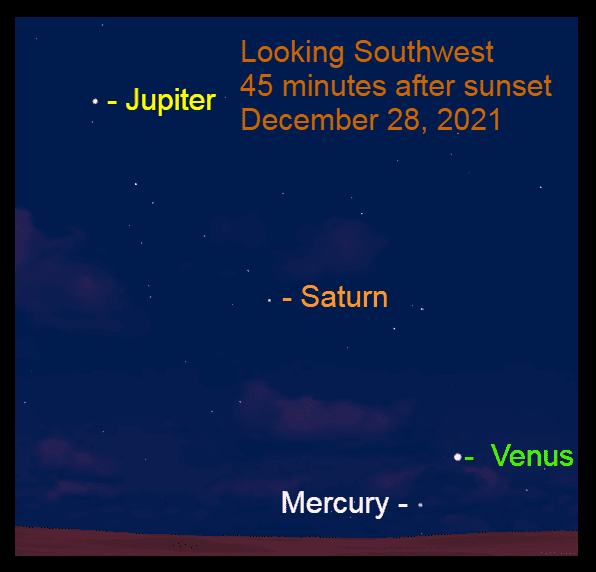Sky Shorts: Don't miss launch of a most impressive telescope

Whether you are a night sky observer or space exploration enthusiast, there will be plenty of excitement as we close out 2021.
James Webb Space Telescope
The big news is the launch of the James Webb Space Telescope, the most powerful infrared space telescope ever built, on Dec. 18! Inspired by the Hubble Space Telescope, the JWST will look back in time to when galaxies formed right after the Big Bang, 13.5 billion years ago. It will change our understanding of the universe and our place in it. NASA, the European Space Agency, and the Canadian Space Agency are partnering on the mission. The launch site is at the European Spaceport located near Kourou, French Guiana, on the northeastern coast of South America. The JWST has the world’s largest primary mirror, six times the size of Hubble’s primary mirror. There are 18 mirror segments that are designed to be folded like origami to fit into a rocket fairing. The JWST will operate in very cold temperatures and heat from the Sun, Earth and Moon will be blocked by a special heat shield, the size of a tennis court. The JWST will be located 1,000,000 miles away from Earth at Lagrange 2, a point of gravitational equilibrium. In an impressive engineering feat, JWST will unfold over one month until arrival at Lagrange 2.
Venus at greatest brilliancy
Without a doubt, if you are out on a clear evening after sunset, you will spot dazzling Venus low in the southwestern sky. Venus will reach greatest brilliancy on Dec. 4, shining at magnitude -4.9. The Crescent Moon joins Venus on Dec. 6 for a spectacular pairing. As we head through the month of December, Venus will undergo a fast transformation. This transformation occurs when Venus approaches inferior conjunction, which happens early in 2022. Inferior conjunction is when Earth and Venus make their closest approach to each other. As Venus comes closer to Earth, the apparent size increases and the phase changes. The most exciting phase to watch is the crescent. On Dec. 1, Venus shows a 28% crescent, 15% crescent on Dec. 16, 10% on Dec. 21 and just 5% on Dec. 27. But as Venus thins, it grows in angular size. Time to get out your backyard telescope!

Comet Leonard
Discovered by Astronomer Greg Leonard, Comet C/2021 A1 (Leonard) may become the brightest comet for 2021. Comet Leonard’s closest approach to Earth will be on Dec. 12. Although the comet will be close to the horizon, we might have good views using binoculars. Around Dec. 14-16, Comet Leonard will become visible just after sunset, very low in the southwest. Comet Leonard will be just below Venus on Dec. 17, 30 minutes after sunset. Grab your binoculars and scan below Venus for the fuzzy glow of the comet’s coma. Let’s keep our fingers crossed that it will be brighter than predicted and reach visibility to the unaided eye and show a tail.

Night Sky for December
Planets and the Moon – It will be another fabulous planet viewing month in our early evening sky! Venus, Saturn and Jupiter continue to put on a wonderful show in the south-southwestern sky. On Dec. 14, the three planets will be at their least span apart of 31.4 degrees. Venus appears first, low in the southwestern sky and is the brightest of the three. Jupiter appears second and is to the upper left of Venus. Saturn is the faintest and is between Venus and Jupiter. As Venus brightens, Jupiter begins to dim. Jupiter starts the month at magnitude -2.3 and quickly dims to 0.1 magnitude by Dec. 14. By the end of December Jupiter will set at 9 p.m. Saturn shines at magnitude 0.6 and will make a close pairing with Venus, 14 degrees apart, on Dec. 16. Saturn is best viewed in the first two weeks of the month and will set by 7 p.m. on Dec. 31. Mercury joins the group, late in the month, and will be below and to the right of Venus. On Dec. 28, Mercury and Venus pass each other by 4.2 degrees. The Moon passes south of Saturn on Dec. 7 and south of Jupiter on Dec. 9. Neptune, magnitude 7.8, is located in Aquarius and lies 3 degrees northeast of the star Phi Aquarii on Dec. 1. Neptune stands 4.5 degrees north of the First Quarter Moon on Dec. 10. Uranus, magnitude 5.7, is located in Aries and is 11 degrees south of the brightest star in Aries, Hamal. Uranus can be spotted 3 degrees northeast of the Gibbous Moon on Dec. 14. Mars reappears in the morning sky, at magnitude 1.6, and on Dec. 25 is less than 5 degrees north of its rival, the star, Antares, which is brighter of the two. The crescent Moon joins Mars and Antares on Dec. 31 as we ring in the New Year.
Constellations:
East – The most magnificent picture in our stars, Orion, the Hunter, returns to our night sky. Look for the three stars in a line, which make up the belt of Orion. The bright red-orange star up and to the left of the belt is Betelgeuse. The bright blue-white star down and to the right of the belt is Rigel. Draw a line up from the belt to a red, orange star, Aldebaran, which is the eye of Taurus, the Bull. The sideways V shape is the face of Taurus. Above Taurus, the small cluster of stars is the Pleiades or Seven Sisters. Making a counterclockwise loop from the Pleiades, the next bright star is Capella. Continuing down, the two stars you see are Gemini, the Twins.
North – The Big Dipper is low on the horizon. Following the two stars at the end of the cup to the next bright star, is Polaris or the North Star. The constellation Cassiopeia is above Polaris and resembles the letter ‘M.” West: Sinking lower are the bright stars Vega, Deneb and Altair which form the Summer Triangle.
Binocular highlights – When facing north, locate the “M” shape of Cassiopeia. From the left point of the “M” shape, scan slowly up to the left. You will see a fuzzy circular shape. That is the Andromeda Galaxy. From the right point of the “M,” scan up slightly. You will come upon the Double Cluster in Perseus. Facing east, you will see a small cluster of stars, the Pleiades or the Seven Sisters. The Pleiades is a beautiful open star cluster. Head to Orion, the Hunter. Scan below the three stars of Orion’s belt. You will see a fuzzy area with bright stars. This is the Orion Nebula, a hydrogen gas cloud where new stars are forming. The Winter Solstice will occur at 10:59 a.m. Dec. 21. The peak of the Geminid Meteor Shower is Dec. 13-14 but moonlight will interfere.
For further night sky details, maps and audio, visit my website www.starrytrails.com.
Hoover Price Planetarium
Visit www.mckinleymuseum.org, for holiday show dates and times! Planetarium shows are free with Museum admission. Seating is limited and will be on a first come, first serve basis. The Planetarium is located inside the McKinley Presidential Library & Museum, 800 McKinley Monument Drive NW, in Canton. For more information, please call the Museum at 330-455-7043.

This article originally appeared on The Repository: Sky Shorts: Don't miss launch of a most impressive telescope

